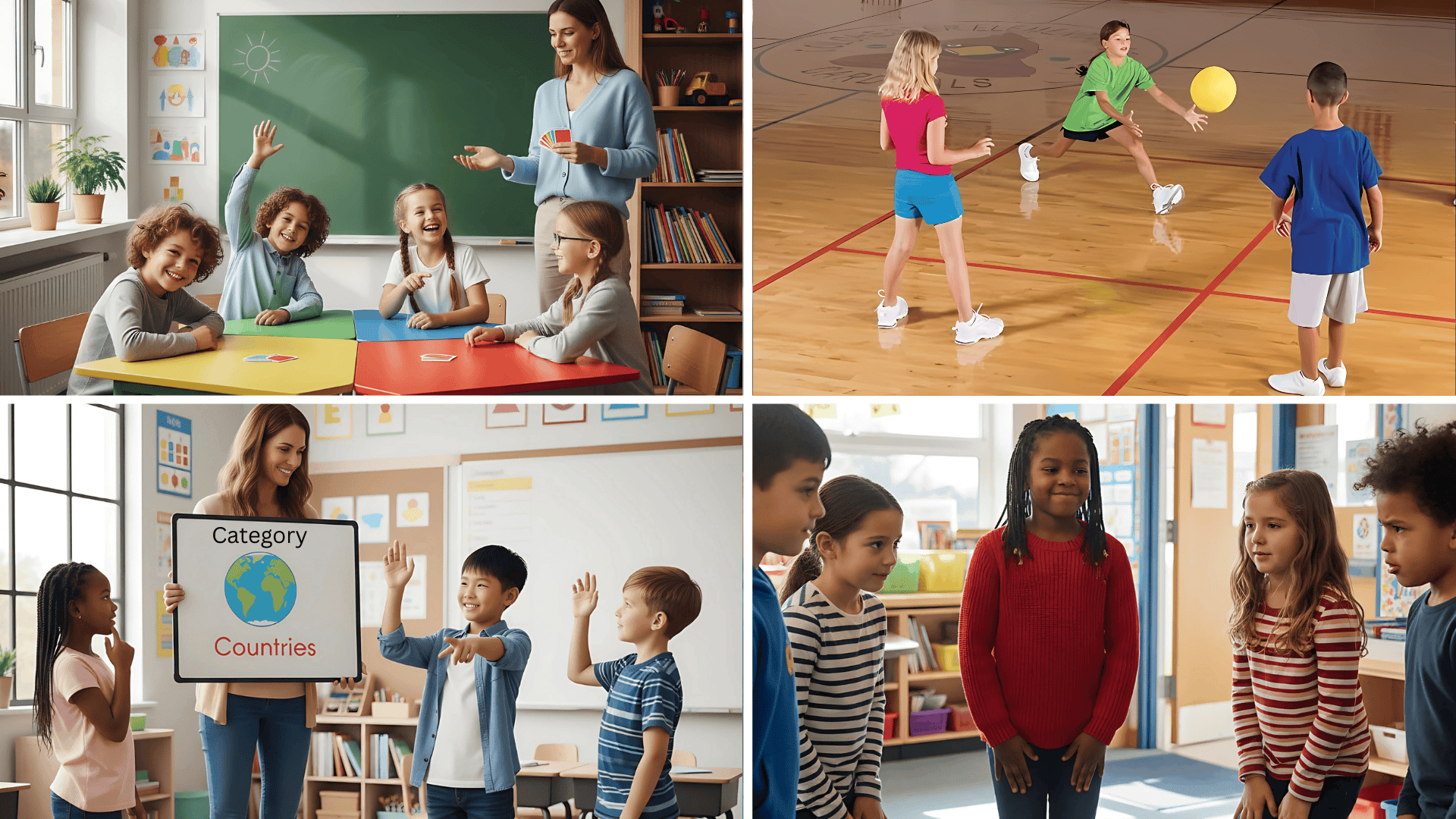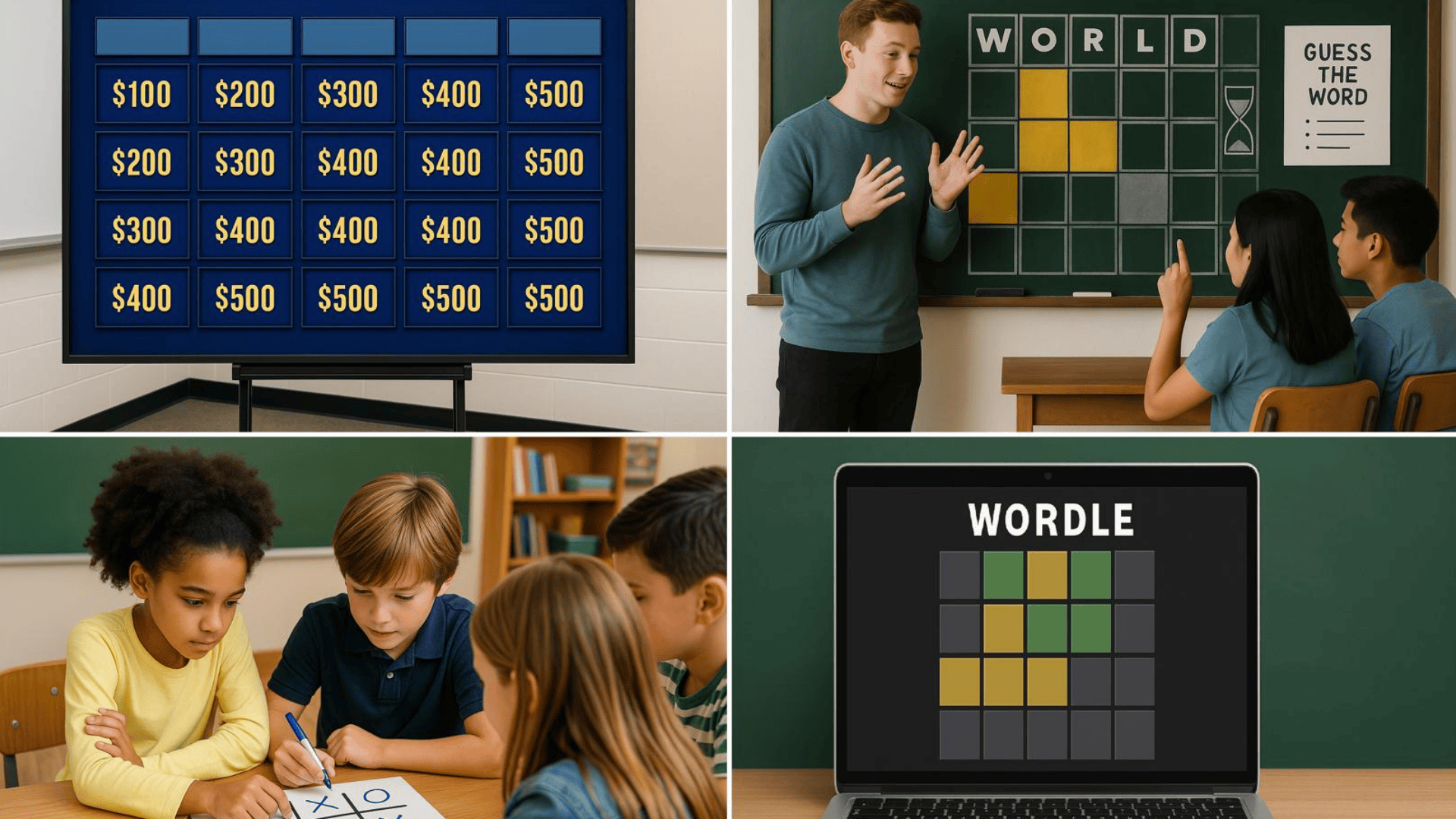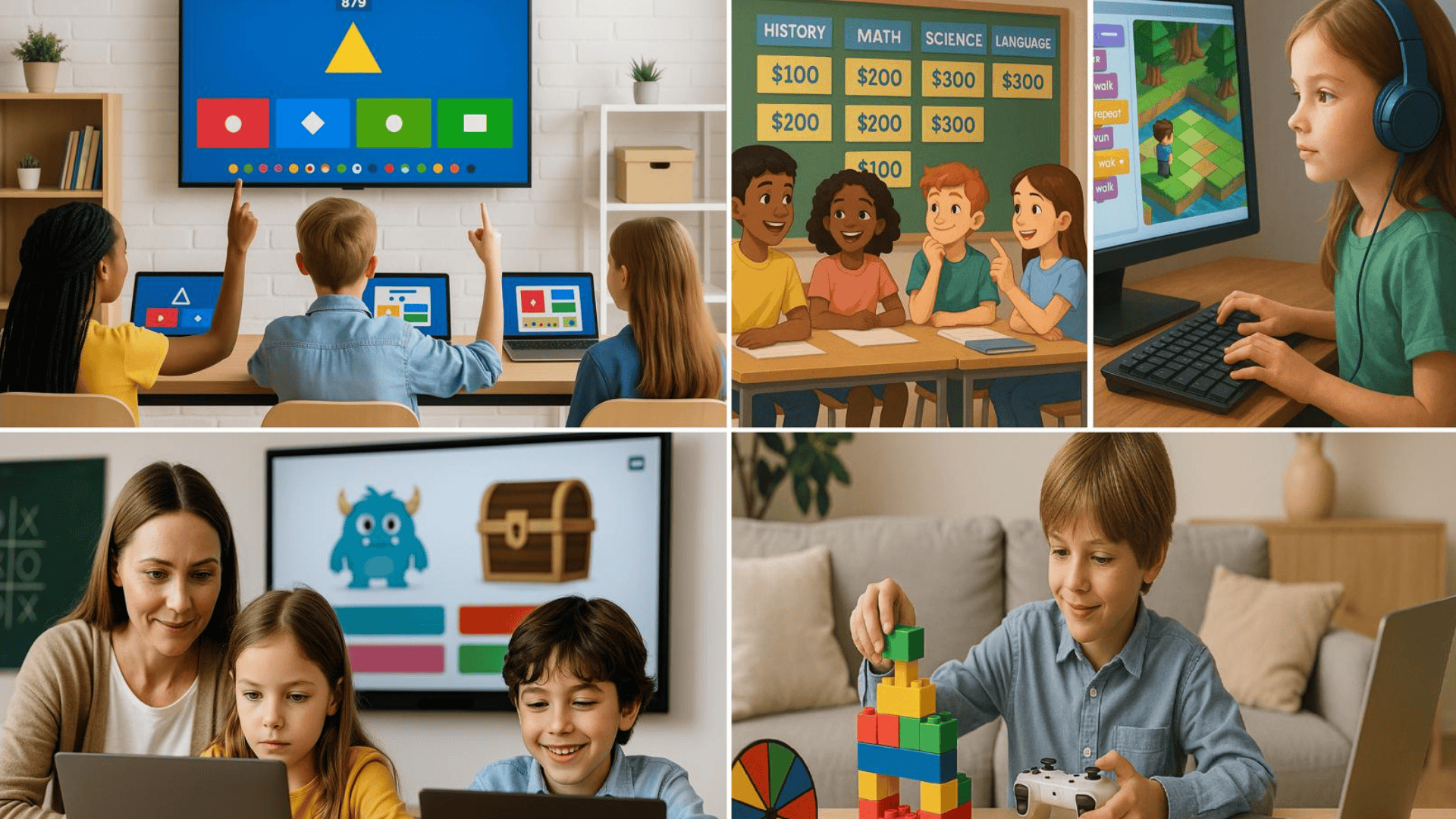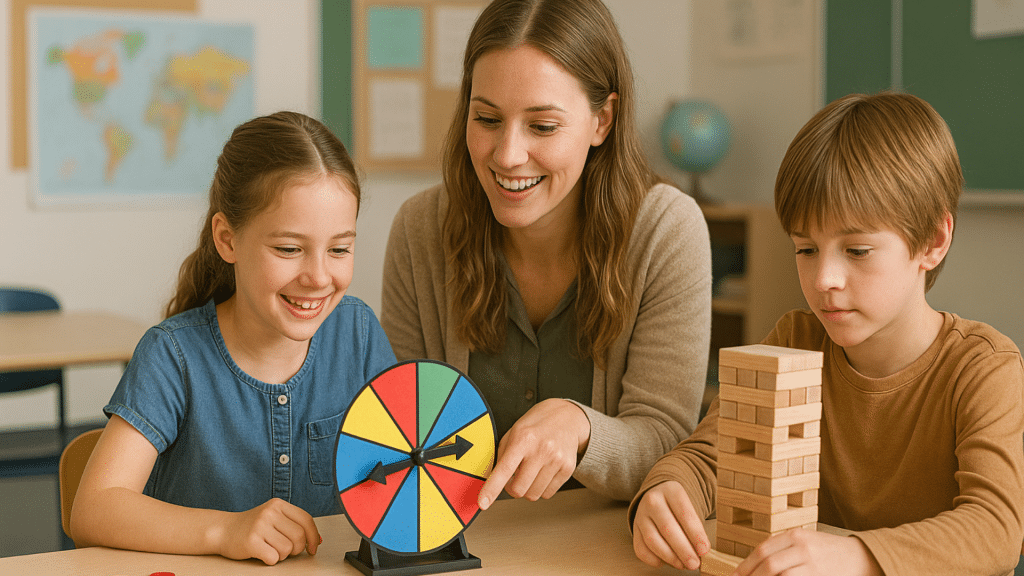Classroom games are a simple yet powerful way to keep students focused, motivated, and ready to learn.
They bring variety to lessons, making it easier for students to stay active and connected without feeling like they are only working through assignments.
I’ve seen the right game shift the energy of the room within minutes, helping both calm restless groups and build interest in quieter ones.
Today, I’m listing activities that support teamwork, recall skills, and creativity while giving teachers flexible options for any situation.
From no-prep fillers to subject-based challenges, classroom games work across ages and settings. Let’s look at some practical ideas you can use right away.
Classroom Games to Make Learning Fun
These classroom games range from quick fillers to subject-based challenges, giving you flexible options to match time, energy, and learning goals.
No-Prep Quick Games

These games need little to no setup and are perfect for filling short gaps in class time.
1. Heads Up 7 Up
This classic game works well when you need a quick filler. A small group of students comes to the front while everyone else puts their heads down with thumbs raised.
The front group taps classmates’ thumbs and returns quietly. Those tapped, then guess who picked them. It’s a short game that keeps the whole class engaged.
2. Silent Ball
Silent Ball is perfect when the class has extra energy, but you still want quiet. Students toss a soft ball around the room without talking. If someone speaks, drops the ball, or tosses poorly, they’re out.
The game continues until one player remains. It’s simple, fun, and helps calm the room while encouraging focus and careful coordination.
3. Copy Cats
In Copy Cats, one student leaves the room while another becomes the leader. The leader starts small movements like clapping or tapping, and the class follows. The first student returns and tries to spot the leader.
The game keeps everyone alert and builds observation skills. It’s short, lighthearted, and requires no setup, making it ideal for transitions.
4. Hot Potato
Hot Potato works well for quick energy bursts. Students pass a small object around the circle while music plays. When the music stops, whoever is holding the item is out.
Play continues until only one student is left. The game is fast, fun, and builds excitement in just a few minutes, making it perfect for short breaks.
5. Time-Killer Fillers
Sometimes you only need to fill a few minutes. Games like “I Spy,” quick trivia questions, or word association work well here. These games require no supplies and keep students’ minds busy until class ends.
They’re especially helpful at the end of a lesson when you don’t have time to start something new but still want engagement.
6. Four Corners
Label the corners of the classroom with numbers or categories. Students pick a corner, and one student in the middle calls out a number or category. Everyone in that corner is out.
It’s a fun movement game that also helps with decision-making.
7. Categories Game
Choose a topic like animals, countries, or foods. Students go around the room saying one item that fits the category without repeating answers. The game strengthens recall skills and works well as a quick filler.
It’s simple, flexible, and keeps the whole class thinking on their feet.
Brain Breaks & Movement Games

These games give students a chance to reset, release energy, and return to lessons with better focus.
8. The Floor is Lava
Students imagine the floor is lava and move across the room without touching it. They step on safe spots like mats or chairs to reach the other side.
The game builds quick thinking and teamwork while giving students a short break from lessons. Always set safety rules before starting.
9. Scavenger Hunt Variations
Scavenger hunts get students moving and thinking. You can adapt them for letters, colors, shapes, or even math problems. For example, call out “something red” or “a triangle,” and students search the room to find a match.
It builds observation skills and attention to detail. The flexibility makes it easy to connect with almost any subject or topic.
10. Freeze Dance / Simon Says
Both games mix fun with self-control. In Freeze Dance, play music and let students move freely. When the music stops, they must freeze in place. In Simon Says, students only follow commands when they start with “Simon says.”
These games are lively but also encourage listening and quick reactions, making them a good choice when energy is low.
11. Relay Races
Relay races can be adapted to nearly any classroom size. Students form teams and complete tasks like passing a ball, writing a word, or solving a math problem before handing off to the next teammate.
This game adds movement, teamwork, and a little friendly competition. It’s especially effective in larger spaces, but can be adjusted for smaller classrooms too.
12. Animal Charades
Animal Charades combines creativity and movement. Students act out different animals without speaking while their classmates guess. You can choose animals related to science topics or let students suggest their favorites.
It encourages imagination, helps break the ice, and keeps energy high. Since no materials are needed, it’s a simple way to add fun to any lesson.
13. Pictionary Relay
Divide the class into teams. One student from each team draws a word or concept on the board while teammates guess. The first team to answer correctly scores a point. It combines creativity, speed, and teamwork.
The fast pace keeps students engaged and encourages active participation from everyone on the team.
14. Telephone
Students sit in a line or circle. The first student whispers a phrase to the next, and it continues until the last person says it out loud. The final answer is compared to the original, often with funny results. This game sharpens listening and memory.
Review & Learning Games

These games make reviewing lessons more active and help students practice key skills in a fun, low-pressure way.
15. Jeopardy
Jeopardy is a flexible review tool. Create a board with categories and point values related to your subject. Students answer questions in teams to earn points. It builds recall skills while adding competition.
Teachers can easily adjust the difficulty to fit any grade level. The game also encourages teamwork as students discuss answers before responding.
16. Bingo
Bingo works across many subjects. Create cards with terms, numbers, or vocabulary words. Call out definitions, problems, or clues, and students mark the matching space. The first to complete a row wins.
Bingo is interactive, reinforces key concepts, and can be used for math, language, or history review. It’s simple to set up and enjoyable for all ages.
17. Tic Tac Toe Review
Tic Tac Toe Review mixes the classic game with study practice. Teams compete to place an X or O on the board by answering questions correctly. Each correct answer earns a spot.
The game pushes students to think carefully, since blocking and strategy are key. It keeps reviews lively and works best in smaller groups for fast play.
18. Wordle Classroom Adaptation
Turn the popular online game into a class activity. Choose a word and let students guess letters or whole words within a set number of tries. Give feedback after each guess, showing correct letters.
It’s perfect for spelling, vocabulary, or subject-specific terms. The format keeps students curious and motivated to solve the word before the chances run out.
19. Stump the Expert
In this game, students prepare questions to challenge a class “expert,” which could be a teacher or a student chosen earlier. The expert tries to answer each question, and if they miss, the challenger earns a point.
It builds critical thinking and gives students ownership of the review process. The game also encourages interesting class discussions.
20. Guess the Word (Taboo style)
A student gives clues about a word without using specific “taboo” words. The team must guess before time runs out. It’s perfect for vocabulary practice and encourages creative communication.
The time limit adds excitement and keeps the activity fast-moving, which holds students’ attention.
Teamwork & Social Games

Teamwork and social games help students interact, build trust, and strengthen group skills through simple and enjoyable activities.
21. Human Bingo
Each student receives a bingo card with prompts like “has a pet,” “can whistle,” or “plays soccer.” Students walk around and find classmates who fit each prompt, writing down names.
The first to complete a row calls bingo. This game builds connections, encourages conversation, and works well at the start of the year to help students learn about one another.
22. Make Me Laugh
Two students face each other while classmates try to make them laugh without touching. The first to laugh loses. It’s a light game that builds confidence and adds humor to the classroom.
Teachers can guide what kinds of jokes or faces are allowed to keep it safe and inclusive. It’s a quick way to release energy and stress.
23. Group Storytelling
Students take turns adding one line to a story. Each line builds on the one before, creating funny or unexpected results. This game strengthens listening skills and sparks creativity.
You can make it subject-based by starting with a theme, like history or science, or keep it open-ended. The unpredictable results keep students entertained while practicing teamwork.
24. Cooperative Scavenger Hunts
Instead of competing, students work together to solve a set of challenges or find specific items around the classroom. Tasks might include solving riddles, identifying objects, or answering subject-based clues.
The focus is on cooperation rather than competition. It builds teamwork, problem-solving, and group communication while still keeping students engaged and moving.
25. Two Truths and a Lie
Each student shares three statements, two true and one false. Classmates guess which one is the lie. The game builds speaking, listening, and social skills.
Teachers can adapt it with academic themes, such as science facts, to connect it to lessons.
Digital & Online Classroom Games

Digital games use technology to make lessons interactive. Many platforms let teachers customize activities for any subject. They also support blended or remote learning since most work on laptops, tablets, or phones.
26. Kahoot, Quizizz, and Gimkit
These quiz platforms let teachers design interactive games that students join with a code.
Kahoot is simple and fun for a quick review. Quizizz allows self-paced play with instant feedback. Gimkit adds game currency that students earn with each answer.
All three support multiple subjects, offer free plans, and have premium upgrades. They’re perfect for review, competition, and active participation.
27. Baamboozle and Blooket
Baamboozle and Blooket are best for group competitions. Baamboozle can run from one screen, making it ideal when devices are limited. Blooket offers a variety of modes like races or survival games, which keep students interested.
Both platforms have libraries of ready-made quizzes and allow teachers to create their own. They are easy to set up and flexible for many subjects.
28. Minecraft Education
Minecraft Education turns learning into a creative, immersive experience. Students build, learn, and solve problems in a virtual world. Teachers can design challenges connected to math, history, or science lessons.
It works well for group projects and encourages creativity and teamwork. The platform requires a paid license, but it’s widely used for its ability to make complex topics hands-on.
29. Prodigy Math and Code.org
Prodigy Math is an adventure-style game where students solve math problems to progress. It adapts to each student’s skill level, making practice more personalized. Code.org offers coding games that teach programming basics through puzzles and challenges.
Both platforms are free to use and great for subject-specific practice. They mix play with learning and help students build lasting academic skills.
30. Google Classroom Add-ons
Some games connect directly to Google Classroom through add-ons. These tools let teachers assign interactive quizzes, flashcards, or puzzles as part of their lessons. Students can play while completing their assignments, and teachers track progress easily.
The setup is simple since it links to the platform many schools already use. It’s a convenient option for blending play with structured work.
31. Hybrid Play
Hybrid play combines offline activities with online scoring or digital tools. For example, you can run a relay race in class while tracking team scores on Quizizz or play bingo on paper while calling answers from a digital board.
This approach combines the fun of traditional games with the convenience of technology. It works well for teachers easing into digital learning.
Subject-Specific Game Tools
Subject-specific game tools make lessons more engaging and give students extra practice while having fun. Here are some of the most effective options across different subjects:
| Subject/Area | Tools | Description |
|---|---|---|
| Math | Prodigy, Math Playground | Prodigy adapts to each student’s level with role-playing math, while Math Playground offers practice in arithmetic, fractions, and problem-solving. |
| Spelling & Vocabulary | Spelling City, Wordwall | Spelling City turns word lists into interactive games like scrambles and crosswords, while Wordwall provides match-ups and missing word puzzles. |
| Science & History | Digital Scavenger Hunts, Virtual Labs | Scavenger hunts guide students to find facts online, while virtual labs provide safe, hands-on experiments for science and history. |
| Reading, Writing & Language | Story-Building Apps, ESL Kahoots, Grammar Games | Story-building apps let students create digital stories; ESL Kahoots offer grammar and vocabulary practice; grammar games include scrambles and error hunts. |
These tools not only reinforce classroom learning but also keep students motivated through play. Choosing the right mix can make everyday lessons more interactive and memorable.
Choosing the Right Game for Your Classroom
Picking the right game depends on student needs and how the class is set up. The right match keeps learning smooth and students engaged.
- Class size: Large groups do well with whole-class games like Jeopardy or Human Bingo. Small groups work better with activities such as Copy Cats or Tic Tac Toe.
- Tech availability: If your devices and internet are ready, try Kahoot or Quizizz. In low-tech rooms, use paper-based or no-prep options.
- Student age: Younger children enjoy active games like Simon Says or Hot Potato. Older students often prefer strategy-based choices such as Jeopardy, Blooket, or Minecraft Education.
- Energy level: For calm, use Silent Ball or Wordle. For a quick energy boost, pick Freeze Dance or relay races.
- Offline vs. online: Offline games are great for quick sessions or limited tech. Online platforms add scoring, customization, and variety. Mixing both creates flexibility.
Choosing games with your class in mind helps balance fun and focus. The right choice encourages participation and supports steady learning.
Wrapping Up
Classroom games play a powerful role in keeping students engaged while supporting learning goals. They give teachers tools to review lessons, encourage teamwork, or simply manage energy levels during the day.
Mixing traditional activities with online classroom games creates balance, giving students both movement and meaningful practice. The real value lies in picking games that match the class size, subject, and available resources, so every activity feels purposeful.
If you enjoyed these ideas, don’t stop here. Read my other blogs on classroom games for more creative strategies, detailed guides, and practical tips to keep your students excited about learning.
Frequently Asked Questions
Can classroom games be played outdoors?
Yes, games like relay races, scavenger hunts, and “The Floor Is Lava” can be adapted outdoors. Outdoor play adds more space for movement and is especially useful for high-energy activities or larger class sizes.
How do classroom games help shy or introverted students?
Games provide a structured way for shy students to participate without pressure. Options like Bingo, trivia, or team-based digital platforms allow them to join in comfortably while building confidence over time.
What are some eco-friendly classroom games?
Games that use no extra materials, like charades, trivia, or word association, are eco-friendly options. They rely only on student participation, making them sustainable and easy to run anytime











